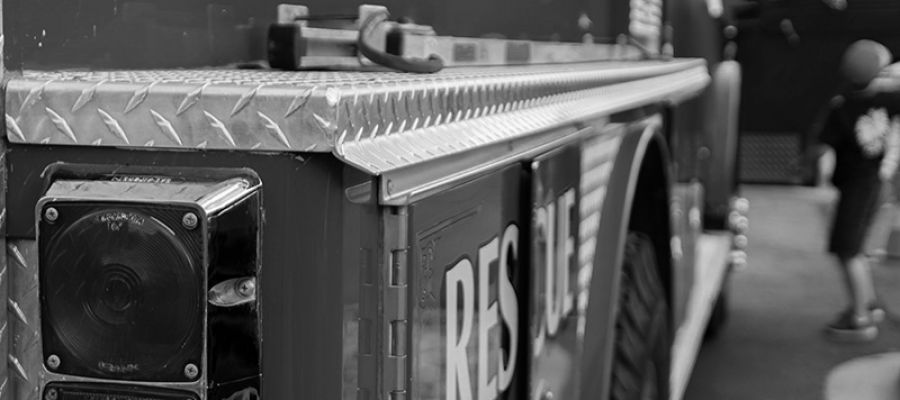What if I Am in an Accident With an Emergency Vehicle?

We have all seen fire trucks, police cars and ambulances racing down the road with their flashing lights on. But if you are involved in an accident with one of these vehicles, who is liable? The answer depends on the circumstances. The Alberta Highway Act gives emergency vehicles responding to a call the right of way over other vehicles, but they must proceed safely.
What Liability Does the Emergency Vehicle Driver Have for Accidents?
According to Alberta's Traffic Safety Act, drivers of emergency vehicles may exceed the speed limit, go through red lights and contravene other regulations, but only if "it is reasonable and safe to do so." It notes that "use of the red flashing lights alone does not exempt the driver from the rules of the Act," as operators of emergency vehicles are only allowed to "disregard some traffic laws under limited circumstances. Failure to meet the requirements of these circumstances means that the driver may be subject to Civil and Criminal penalties in the event of a collision." It adds that even during the most serious emergency, an emergency vehicle driver "must consider the safety of others."
What if I See an Emergency Vehicle Approaching?
When a fire truck, police car or ambulance approaches with its siren or lights one, either from behind or in the oncoming lane of a two-lane roadway, you should pull over to the right side of the roadway in a safe manner and stop. Remain stopped until the emergency vehicle has passed and it is clear no other emergency vehicles are approaching. On one-way streets or streets divided by a median, drivers should move left or right to the nearest curb. Don't enter an intersection until the emergency vehicle is completely through it, even if you have a green light. The only exception to this rule is when a peace officer gives you other directions.
What if I See Flashing Lights in Front of Me?
Flashing lights from emergency vehicles warn of a problem ahead. Reduce your speed, get into the right lane, and be prepared to stop. In Alberta, when passing emergency vehicles or tow trucks that are stationary and have their lights flashing, motorists must reduce their speed to 60 km/hr or the posted speed, whichever is lower.
How is Alberta's 'Move Over' Law Different?
In 2005, Alberta amendments were made to the province's Traffic Safety Act to require drivers to either slow down or move over when passing emergency vehicles or tow trucks stopped on the side of a highway when their lights are flashing. The maximum speed for passing stationary emergency vehicles or tow trucks was set at 60 km/h. The fines for exceeding that speed were doubled for drivers passing an emergency vehicle, but only in the lane next to the stopped emergency vehicles. In all other provinces, drivers in all lanes must slow down to 60 km/hr in that emergency situation.
What Not to Do in an Emergency Situation
Do not jam on the brakes or force your way into the right lane. Instead, slow down and change lanes when possible. If you are on a multiple-lane highway and the right lane is still moving, continue at a steady pace, not above 60 km/hr and let drivers into your lane. Suppose you are on a divided highway and see emergency vehicles coming in the opposite direction. It would be best if you did not slow down, as that will cause confusion for vehicles behind you and may cause accidents.
Can I Drive Behind a Vehicle with Flashing Lights?
Drivers in Alberta must stay at least 150 metres, which is 1.5 times the length of a football field, behind an emergency vehicle with its siren and/or flashing lights on.
What if the Vehicle has Flashing Green Lights?
Treat flashing green lights like any other emergency vehicle. In some municipalities, volunteer firefighters use flashing green lights on their vehicles when responding to an emergency.
What if a Tow Truck has Flashing Lights?
Although tow trucks are not classified as emergency vehicles, Edmonton Police Service states that Alberta's traffic laws require motorists to slow down to 60 km/hr when passing a tow truck with its lights activated on the side of the road. If there is a tow truck behind you with its lights activated, police say you should safely move to the right lane to allow it to pass and stop if necessary.
How Often are Emergency Vehicles in Accidents?
According to one Canadian report, each year, more than 300 road traffic accidents in Alberta involve at least one emergency vehicle, such as an ambulance, police car or firetruck. A U.S. study found that vehicle collisions are the second-most common cause of firefighter fatalities.
AFTER AN ACCIDENT, CONTACT US
A personal injury lawyer can help guide you through your options and help you obtain the compensation you need to help you recover from any injuries. They can also make sure that your insurance company does not attempt to limit the compensation that you are owed. Schedule your Free Consultation by calling 1 (403) 930-8594 or send a message to kantor@kantorllp.ca. We will represent you on a contingency fee basis, so we do not get paid for our time and attention until we settle.
